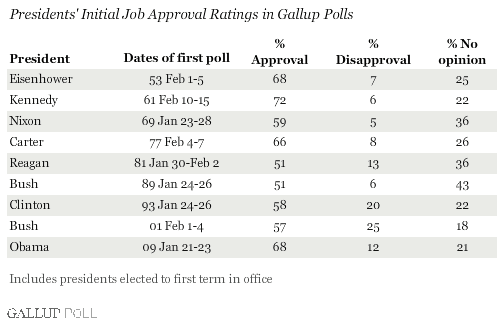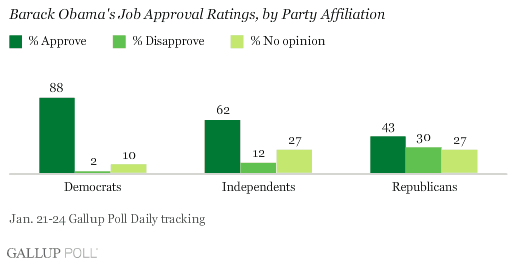PRINCETON, NJ -- With a 69% job approval rating in the latest Gallup Poll Daily update, Barack Obama continues a strong start to his presidency. That rating follows his initial approval rating of 68% -- based on Jan. 21-23 polling and reported Saturday -- and ranks him near the top of the list of presidents elected after World War II.

In fact, only John Kennedy had a higher initial approval rating -- 72% in 1961 -- though Dwight Eisenhower and Jimmy Carter also had ratings in the mid- to high 60s. But Gallup did not measure those three presidents' initial ratings until early February, and new presidents' approval ratings typically increase in the first few months of their presidencies. Thus, Obama's initial approval rating of 68% looks more impressive compared to the average 55% approval rating for the four presidents whose first ratings were measured in January after their inaugurations.
In general, the American public rates all new presidents positively -- all have received majority approval in their debut ratings -- though Obama is clearly near the top of the list. The three presidents who took office after the death or resignation of their predecessors tended to start out with even greater public support, as the nation rallied around the new chief executive in times of crisis. These include Harry Truman in 1945 with an 87% approval rating, Lyndon Johnson with 78% in 1963, and Gerald Ford with 71% in 1974.
Obama's 12% disapproval in Jan. 21-23 polling is low on an absolute basis, but does fall on the high end of what Gallup has measured historically, as the majority of post-World War II presidents have begun their terms with disapproval ratings below 10%. But Obama's higher-than-average first disapproval rating may simply reflect the passing of a bygone political era, as four of the last five presidents (including Obama) have had disapproval ratings above 10% in Gallup's first measurement. The only exception is the elder George Bush in 1989.
However, Obama fares significantly better on this count than his two immediate predecessors -- Bill Clinton (20% disapproval) and George W. Bush (25%). Both started with relatively high opposition from supporters of the other political party -- 41% of Republicans disapproved of the job Clinton was doing in early 1993, and, in early February 2001, 46% of Democrats disapproved of the job George W. Bush was doing as president. By comparison, a relatively low 30% of Republicans disapprove of Obama.
In fact, Republicans are more likely to approve than disapprove of Obama's performance thus far, according to an average of the first four days of Gallup tracking on Obama job approval. More than 6 in 10 independents, and nearly 9 in 10 Democrats, approve.

At the outset of his presidency, Obama has majority approval from all ideological groups, including 83% of self-identified liberals, 75% of moderates, and 52% of conservatives.
In addition to liberals and Democrats, two of the key groups from Obama's winning electoral coalition -- young adults (79% of 18- to 29-year-olds) and nonwhites (78%) -- give him especially positive initial evaluations.
And, consistent with the pattern of last year's election campaign, women (71%) are more positive toward Obama than are men (64%).
Survey Methods
Results are based on telephone interviews with 1,614 national adults, aged 18 and older, conducted Jan. 22-24, 2009, and 1,591 national adults, aged 18 and older, conducted Jan. 21-23, 2009. For results based on these total samples of national adults, one can say with 95% confidence that the maximum margin of sampling error is ±3 percentage points.
Interviews are conducted with respondents on land-line telephones (for respondents with a land-line telephone) and cellular phones (for respondents who are cell-phone only).
In addition to sampling error, question wording and practical difficulties in conducting surveys can introduce error or bias into the findings of public opinion polls.
